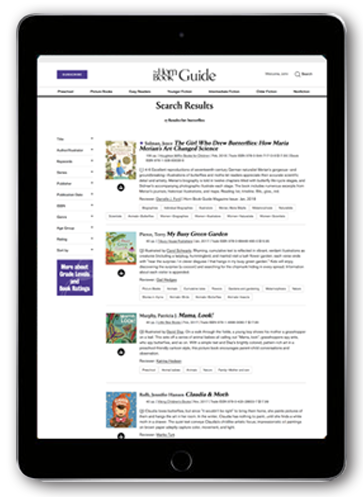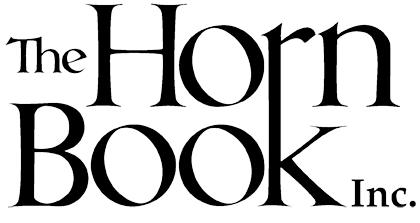Genetics
79 Reviews
 Alexander, Lori
Alexander, Lori
Seeds of Discovery: How Barbara McClintock Used Corn and Curiosity to Solve a Science Mystery and Win a Nobel Prize
(2)
K-3
Illustrated by
Rebecca Santo.
"It might seem unfair to reward a person for having so much pleasure over the years." Geneticist Barbara McClintock's (1902–1992) statement upon receiving the Nobel Prize in the category of Physiology or Medicine in 1983 sets the tone for Alexander's accomplished biography of an extraordinary life in science. The account begins with McClintock's childhood, when she showed early interest in and capacity for science at a time when few women were encouraged to do so. Throughout her career, despite sexism and others' misperceptions, McClintock persisted and thrived, most contentedly at Cold Spring Harbor Laboratory on Long Island, where as a research scientist she studied the genetics of maize and discovered "jumping genes," the relocation of DNA segments across the genome. Alexander's descriptions of laboratory and field work are detailed and effective at illustrating scientific experimentation. Most impressive is her equal attention to the conceptual practices of science, such as developing questions and models, scientific argumentation, and the importance of communicating ideas for scrutiny within the scientific community. Santo's digital illustrations use pastel shades to portray McClintock outdoors for work and for nature walks, in the laboratory, and presenting her research at conferences. Text boxes throughout provide background biology concepts and introduce important historical contributors such as Gregor Mendel and Rosalind Franklin. An illustrated timeline of McClintock's major life events, a glossary, and source notes are appended.
Reviewer: Danielle J. Ford
| Horn Book Magazine Issue:
March, 2025
(2)
YA
Turtle, fifteen, is a Mer; she has both lungs and gills from a not-quite-legal "gen-mod" experiment. Gen-modding to cure disease is par for the course in this near-future world, but "boutique" and "transhuman" mods are sometimes illegal and generally looked down upon. The Mer are outsiders in the coastal Texas community of Spoonbill Island (though their difference is useful given increasing flooding due to climate change) and live separately on a refurbished cruise ship. But Turtle, whose biological parents evaded orders at first to hand her over to authorities when she was a child, is drawn to the Normal world—especially after she meets a Normal hottie and learns that her sister still lives on the island. When doctors offer a chance to "reset" to a gill-less life, Turtle makes the Change. With it brings a chance at reconnection with family—including perhaps her father, rumored to have returned after his escape from jail—and a potential boyfriend (or two), as well as the challenges of ostracism from the Mer; letdowns in love; and the ethical considerations of genetic modification. Turtle has a strong, self-aware voice as she navigates her new normal. The romantic elements are as compelling as the philosophical and scientific questions throughout the text, and Turtle's efforts to slow down and observe the world make for moments of beautiful prose. An author's note shares the fairy-tale and scientific inspirations for the story and provides recommendations for further reading.
Reviewer: Monica de los Reyes
| Horn Book Magazine Issue:
July, 2025
 Stone, Tanya Lee
Stone, Tanya Lee
Remembering Rosalind Franklin: Rosalind Franklin & the Discovery of the Double Helix Structure of DNA
(1)
K-3
Illustrated by
Gretchen Ellen Powers.
Stone's dedication -- "For anyone who did something awesome and didn't feel the love" -- sets the reparative tone for this picture-book biography of scientist Franklin (1920–1958), whose Photo 51 cracked the DNA code while competing researchers James Watson and Francis Crick took the credit (and the 1962 Nobel Prize). As she weaves science and history, Stone unravels dual mysteries centering on the double helix: how the "secret of life...makes you -- YOU" and how a "twist of fate" triggered Franklin's posthumous recognition. Powers's watercolors perfectly blend representative and expressive styles. Realistically rendered characters and period details set the story in its mid-twentieth-century milieu, while experimental techniques offer evocative visual commentary; for example, when Franklin argues with Watson and Crick, blue watercolor blotches disrupt the tidy floral border and explode the ground beneath them. Although Stone opens by warning, "This true story doesn't really have a happy ending," Powers's accompanying fairy tale–esque castle, adorned with scientific instruments, foreshadows a time in which readers are empowered to interrogate the historical record and reclaim the stories of little-heralded figures. An author's note explains the Matilda Effect, a historical pattern in which men take credit for women's work.
(1)
K-3
Illustrated by
Philip Bunting.
Ben-Barak and Bunting have impressively produced a thought-provoking, scientifically precise, and accessible explanation of the origins of life and evolution across Earth's history for a young audience. Ideas about life, time, and heredity are conveyed through friendly illustrations and simple sentences (albeit with some sophisticated vocabulary). The book opens with questions that children may ask about their human families and histories: "What is life?" "How did I get it?" A deceptively modest reply, its last phrase repeated throughout the book, serves as an organizing concept as the origins of cellular organisms are explained: "Life Is the Way That Some Things Make More Things That Are a Lot Like Themselves but Sometimes a Little Bit Different." In the final pages, a gorgeous gatefold illustration invites readers to spot familiar plants and creatures (including a human) and trace their paths back to the first cell--a "very clever little bubble." If readers pause to let the statements sink in and look closely at the details in the finely crafted illustrations, they'll find clever subtleties that invite further contemplation about what makes "all of us."
Reviewer: Danielle J. Ford
| Horn Book Magazine Issue:
March, 2023
(1)
YA
McBride (We Are All So Good at Smiling, rev. 1/23) begins this compelling novel in the year 2111: a girl known as Inmate Eleven has lived in a small cell her whole life. All she knows she's learned from Miss Abby, a pale-skinned "Clone" who describes blue-skinned people as "genetic mistakes, which is why we take care of you here." Inmate Eleven's only true companion is her dog, Ira, who will occasionally "go wolf," pacing the cell, looking desperately as if he wishes to be somewhere else. When she finally learns the disturbing truth--that Blues are Black Americans, turned blue from generational trauma; and Clones are white Elitists from the "Bible Boot" of the South--she must escape to save herself. Meanwhile, in the year 2022, young Imogen is struggling with both the racially motivated violence across the country and the catastrophic effects of the COVID-19 pandemic. When Imogen and her mother finally find a therapist willing to listen to her whole story, the juxtaposition of past, present, and future creates a jarring narrative. Interspersed throughout are Bible Boot Learning Flash Cards propaganda and asides at the end of Inmate Eleven's chapters touting the virtue of Clones over the "lesser" Blues. A strong voice in the sci-fi genre, McBride presents a fascinating discussion of the inextricable bond between Black Americans and the blues.
Reviewer: Eboni Njoku
| Horn Book Magazine Issue:
November, 2023
(2)
4-6
How does a family live with recurring cancer? Would you want to know if you had that same cancer gene? These questions anchor a powerful verse novel in which twelve-year-old Cass copes with her dad's serious illness and her mom's relentless positivity, and counts on best friend Jayla's steady support. Weaving together genetic research, homeschooling particularities, Christian religious beliefs, and baseball fundamentals, Hill's portrayal of Cass's daily life is full of detail. Her inner monologue drives the story forward; free-verse poetry in a variety of forms relies on Cass's clear first-person voice and creative spacing for effect. Cass grapples with the decision of whether to be tested for the gene. Does she want to know the worst (or best) or does she want to live her life in fear and worry about the unknown? Her situation raises existential questions in ways that are palpable and relevant. Hill delicately balances deep sadness with genuine hopefulness in this distinctive and compelling novel.
(2)
K-3
Illustrated by
Ping Zhu.
A snail possessing a rare left-spiraling shell is found by scientists and named Jeremy, even though it is not male but a hermaphrodite, like all snails. Jeremy not only has a "reversed" shell but its entire anatomy is flipped. This means Jeremy cannot mate with the overwhelming majority of snails because its reproductive parts won't line up with theirs. Popova skillfully employs metaphor to connect Jeremy's story to the underlying science of evolution, as in presenting the explanation of why snails, who can reproduce on their own, prefer to seek a mate: "because diversity is always lovelier than sameness, and because it makes communities stronger and better able to adapt to change." When scientists put out a call to the public to assist Jeremy in finding a partner with the "right" heart--a clever dual meaning--the search for sinistral snails turns up two, eventually allowing Jeremy to mate. Zhu's illustrations, filled with swirling expanses of color, brilliantly portray the concept of a recessive gene as a tiny but persistent snail silhouette inches across the pages and through geologic time.
Reviewer: Danielle J. Ford
(3)
YA
How will genetic modification integrate itself into society going forward? This collection of six interconnected stories, each one set slightly further into the future than the last, imagines teenagers facing different stages of technological advancement and the subsequent questions it raises regarding what it means to love, fear, learn, and be human. The stories cohere into a thoughtful dystopian novel examining technology and the human experience.
Reviewer: Ariel Baker-Gibbs
(3)
YA
Sharks that live to be over four hundred years old? Ten-thousand-year-old plants? Jellyfish that may be immortal? As scientists study these long-living organisms, particularly their DNA, they can learn more about human aging. Plenty of sidebars and photos, as well as the engagingly written text on an interesting topic, make this a good nonfiction choice for reluctant readers. Reading list, timeline, websites. Bib., glos., ind.
Reviewer: Janet Dawson
(2)
YA
Smart, strong high-school senior Grace tries to hide symptoms of the same schizophrenia that caused her mother to abandon the family. Revelatory motifs help readers discern who and what is real in Grace's world. Told in a cycle of voices corresponding to the seasons and moving among first, second, and third person, this is a harrowing, intricately plotted examination of the toll mental illness can take on a family.
Reviewer: Jennifer Hubert Swan
| Horn Book Magazine Issue:
September, 2018
(2)
YA
Estranged twins (and alternating narrators) Tovah and Adina Siegel, whose mother has Huntington's disease, are tested for the gene at eighteen: Tovah didn't inherit it; Adina tests positive. Solomon's debut novel examines how an awful inevitability splinters everyone's vision of the future. The family's Conservative Jewish faith provides refuge for Tovah, but Adina struggles against God. Sprinkled Hebrew dialogue adds intimacy to happy moments and sharpness to disagreements.
Reviewer: Sarah Berman
| Horn Book Magazine Issue:
March, 2018
(3)
YA
After presenting basic facts about the brain and nervous system, Zimmer then discusses the growing knowledge of neuroscience throughout the twentieth century. Subsequent chapters explain the importance of fluorescence and genetic modification in furthering understanding of the brain and developing new treatments for Alzheimer's, Parkinson's, and other disorders. The fascinating survey includes clear color photos, micrographs, and diagrams. Reading list, websites. Bib., glos., ind.
Reviewer: Gail Hedges
(4)
4-6
Fact Finders: Genetics series.
Brief chapters introduce the basics about the microscopic cells that determine characteristics of successive generations of humans, animals, and plants. Spreads include stock photos and diagrams plus occasional fact boxes and sidebars supporting the difficult concepts. The books' scientific complexity may be technically beyond their target readers, but their short length, easy-to-parse page design, and large type add appeal. Reading list. Glos., ind. Review covers these Fact Finders: Genetics titles: DNA, Genes, and Chromosomes and Heredity.
Reviewer: Gail Hedges
(4)
4-6
Fact Finders: Genetics series.
Brief chapters introduce the basics about the microscopic cells that determine characteristics of successive generations of humans, animals, and plants. Spreads include stock photos and diagrams plus occasional fact boxes and sidebars supporting the difficult concepts. The books' scientific complexity may be technically beyond their target readers, but their short length, easy-to-parse page design, and large type add appeal. Reading list. Glos., ind. Review covers these Fact Finders: Genetics titles: DNA, Genes, and Chromosomes and Heredity.
Reviewer: Gail Hedges
(3)
YA
After involuntarily forming cloned versions of herself every year, sixteen-year-old Teva risks her family's safety to uncover secrets from her past that could help break the cycle. Captivating from the first page, this ambitious story about a genetic abnormality vividly conveys the emotions and pain of Teva's unconventional maturation, but also keeps readers guessing as to whether any of this is real.
Reviewer: Lana Barnes
(3)
YA
Advances in genetics allow scientists to consider the possibility of reviving extinct species. Hirsch delves deep into related topics, including evolution, mass extinction, reproduction, and genetic technologies. Case studies of animals such as woolly mammoths and passenger pigeons highlight the feasibility, as well as ethical considerations, of de-extinction. Detailed diagrams and illustrations step readers through the advanced material. Reading list, websites. Bib., glos., ind.
Reviewer: Danielle J. Ford
(3)
YA
Eighteen-year-old Sammie, star debater and high-school valedictorian, refuses to give up her bright future--even to Niemann-Pick Type C, the fatal genetic disease robbing her of memory and eventually bodily control. So Sammie keeps a "memory book" to guide her future self. That book, and this novel, ultimately becomes a gut-wrenching but perceptive record of Sammie's decline and its effects on those around her.
Reviewer: Rebecca Fox
(4)
YA
In 1922, abandoned by her family after contracting polio, Rowan is cast in the Unfit Family show, a carnival sideshow promoting eugenics. After escaping, she and an unlikely ally find themselves uncovering a plot to use "unfit" children as medical guinea pigs. While the plot is uneven, the story's themes and subjects are worth examination; an appended historical note adds value.
Reviewer: Sarah Hannah Gomez
(4)
YA
Injured and separated from her friends in their escape to Mexico, Davy (Uninvited) is rescued by Caden, a fellow Homicidal Tendency Syndrome carrier. Recovering in a resistance cell, Davy must keep her guard up if she wants to reunite with her friends, keep herself safe, and fight her growing feelings for Caden. A well-crafted, if low-stakes, dystopian novel awash in romance tropes.
Reviewer: Rebecca Hachmyer
(3)
K-3
Freaky Nature series.
Bright, well-reproduced color photographs and simply written texts will make this series attractive to science-minded elementary school students. After relating the topic to attention-grabbing material ("Mutants are not just in comic books. In real life, mutations make strange plants and animals"), Larson dispenses well-chosen facts about each "freaky" occurrence in natural life. Readers may be inspired to research further. Reading list, websites. Glos., ind. Review covers these Freaky Nature titles: Mutants in Nature, Super Powers in Nature, Vampires in Nature, and Zombies in Nature.
Reviewer: Miriam Lang Budin
79 reviews
We are currently offering this content for free. Sign up now to activate your personal profile, where you can save articles for future viewing.






















